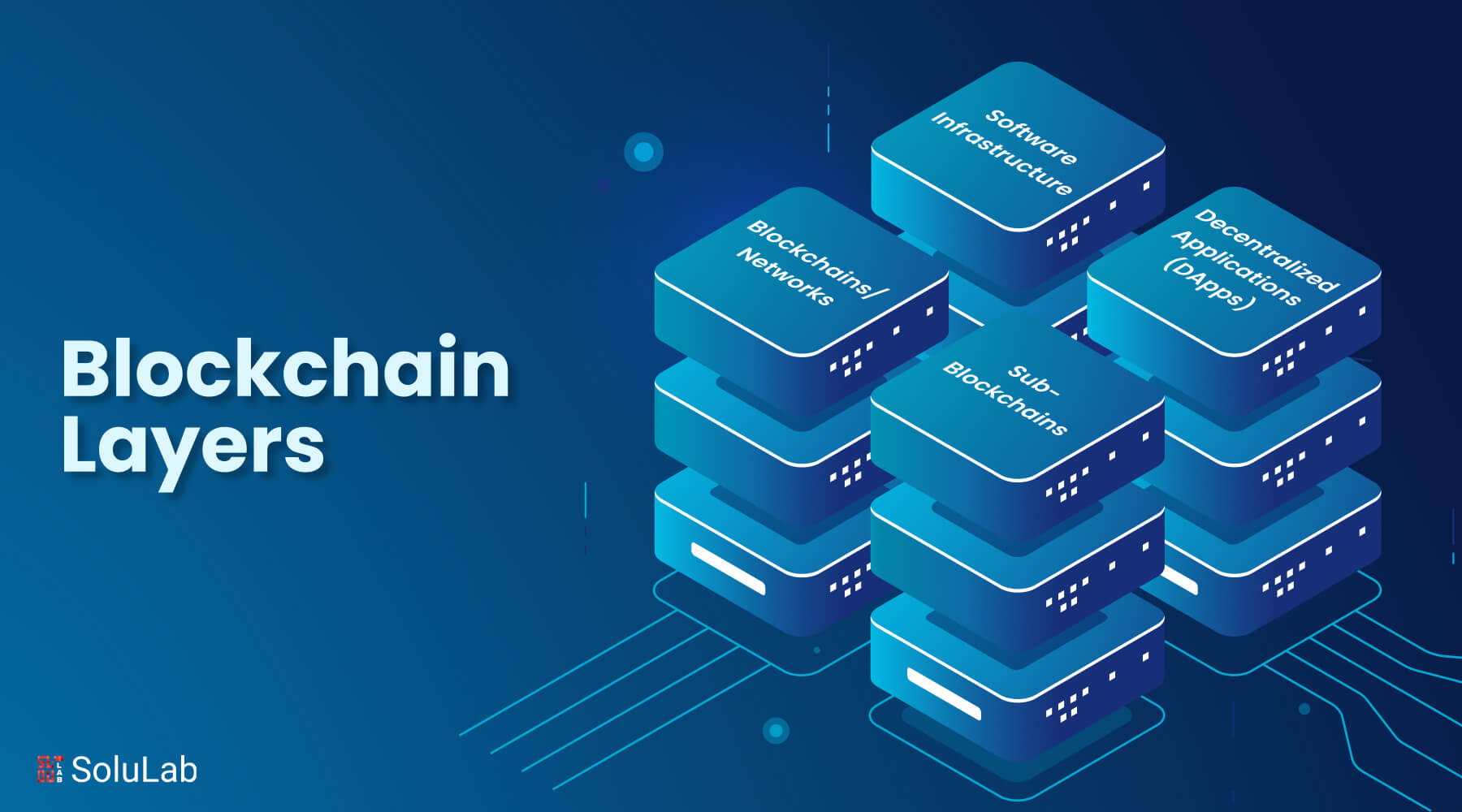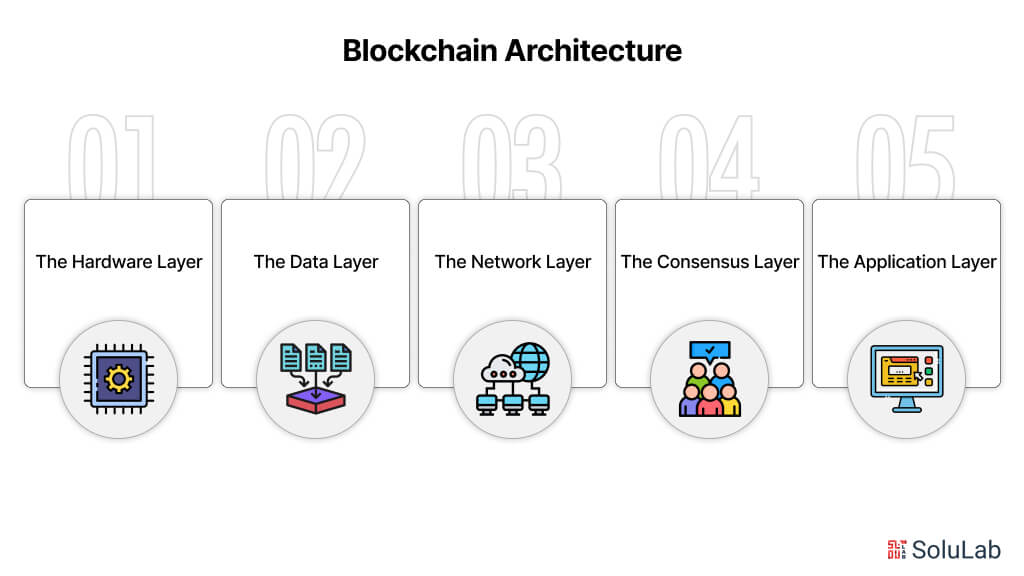
Blockchain architecture pertains to the components, subcomponents, or layers that comprise a comprehensive blockchain system. Each layer has a specific purpose, ranging from data storage to network communication and system-wide consensus.
Understanding these layers of blockchain is critical for engineers and start-up founders looking to use this technology properly.
In this blog, we will explain the complexities of blockchain architecture by breaking it down into layers and their related functionality. Our objective is to assist you in understanding the complexity of blockchain design, optimizing performance, and identifying any security risks.
Overview of Blockchain Architecture

Blockchain has transformed the way information is stored and transmitted. It is widely regarded as the greatest invention of the 21st century, and it will soon be incorporated into ordinary Internet applications. However, because of its intricacy, most people are unfamiliar with how Blockchain works. In this essay, we’ll demystify how blockchains function and the many levels within them in the simplest way possible.
Simply said, blockchain is a distributed ledger used to store transaction data. For example, Bitcoin is powered by the Bitcoin blockchain, and every transaction that involves the sending and receiving of Bitcoins is recorded on the blockchain. Because of its openness, it is a viable alternative to traditional record-keeping and verification methods. This means that any transaction on a public blockchain may be viewed by everyone.
Furthermore, a blockchain is not controlled by a single corporation, but rather by everyone who validates transactions. This eliminates a single point of failure, making blockchain hacking nearly difficult because there is no point of origin. It promotes openness, removes intermediaries, and lowers operating expenses.
Now that we’ve covered the principles of blockchain, let’s look at the layers in blockchain and how they work together.
Blockchain is primarily made up of five layers: hardware infrastructure, data, network, consensus, and application. These blockchain architecture layers have a distinct function. These different layers of blockchain work together to provide a full solution that includes data administration on the back end and user-facing apps on the front end.
-
The Hardware Layer
Blockchains are built around peer-to-peer information exchange. The hardware layer consists of a network of devices that contribute to the blockchain’s computational power. Most significantly, blockchains are the total of all the nodes that compose them. A node is a computer or network of computers that decrypts transactions.
-
The Data Layer
The data layer comes after the hardware layer, and it stores transaction details. The transaction stored in a block (the fundamental unit of a blockchain) contains information on the cryptocurrency delivered, the receiver’s public key, and the sender’s private key. Each data-containing block is linked to the previous and subsequent blocks formed. Only the genesis block, the network’s initial block, is connected forward rather than backward.
Related: Multi-Chain Vs. Cross-Chain: The Future of Blockchain?
-
The Network Layer
This layer handles interactions among nodes on a blockchain. While blockchain is an open system, each node must be aware of the transactions that other nodes are confirming. The network layer facilitates this communication.
-
The Consensus Layer
This layer is accountable for block validation. Let us explain the consensus layer with an example. Let’s assume John and Mark are two blockchain validators. They are given transactions, which must be decrypted and appended to the block.
Transactions that John receives are: A and B
The transactions that Mark gets are B and C.
If both John and Mark confirm the transactions and upload them to the blockchain, transaction B will appear twice on the blockchain. This indicates that double expenditure will occur. To prevent this, John and Mark compete to solve a complex mathematical challenge, and the first person to answer it will add the block to the blockchain. This type of consensus process is known as Proof of Work.
In the case of Proof of Stake (POS), the system selects the validator dynamically.
-
The Application Layer
Apps are created on the application layer in blockchain. These applications might be anything. Examples include wallets, social media apps, browsers, defi apps, and NFT platforms. Though the app’s UI/UX is identical to that of any other conventional application, the distinction is that these apps’ data storage is decentralized at the backend.
What are Blockchain Layers?
Blockchain technology has revolutionized the world of finance and beyond. However, the intricacy of the technology can be frightening for newbies, particularly when attempting to comprehend the various levels that comprise the blockchain ecosystem.
Most people imagine cryptocurrencies in terms of market capitalization, which may be deceptive. A cryptocurrency’s worth is defined not just by its market capitalization, but also by the unique problem it answers, the underlying technology, and the layer of the blockchain ecosystem in which it exists.
So, what are the layers of blockchain? Blockchain layers are the several tiers of infrastructure that collaborate to allow the functioning of a blockchain-based system. Each layer builds on top of the preceding one, and each layer uses the infrastructure of the previous layer.
Related: Layer-1 Vs. Layer-2: The Blockchain Scaling Solutions
To facilitate comprehension, the blockchain ecosystem can be divided into four layers:
-
Layer 0 – Software Infrastructure
Layer 0 refers to all digital technologies that enable blockchains. Layer 0 aims to make blockchain networks viable, accessible, and interoperable. This enables developers to identify more innovative options, resulting in increased token usefulness for consumers. Layer 0 enables functioning blockchains through physical infrastructures including hardware, energy, and Internet services. Decentralization is a key distinction between traditional telecom corporations and Layer 0 initiatives. Layer 0 protocols improve blockchain communication, allowing them to synergize and use each other’s dApp ecosystems.
Cross-chain interoperability protocols (CCIP) are what Layer 0 is all about. Blockchains that are functional with one another can transfer tokens and data with ease. Examples of CCIP initiatives that give blockchains and apps off-chain data are Chain Link, Cosmos, and Polkadot.
-
Layer 1 – Blockchains/Networks
Blockchains are initiatives at Layer 1. Public blockchains are electronic ledgers that make it simple to read and contribute financial data while preventing tampering with already-existing data. Every blockchain has a unique consensus methodology to decide what information should be added, and smart contracts are used to carry out transactions without the need for outside intervention. Smart contracts are independent programs that don’t communicate with users directly, in contrast to apps. While some smart contracts, like those in Bitcoin, simply permit simple payments, others, like those in Ethereum, let programmers design sophisticated applications.
Solana, Ripple, Binance Chain, Monero, and Litecoin are among the more Layer 1 blockchain. Developers select a blockchain according to its design; decentralization, security, and scalability are the top priorities for any network.
-
Layer 2 – Sub-Blockchains
Layer 2 blockchains are created by blockchain developers using existing blockchains as a foundation for their own. They utilize Layer 1 blockchain technology, which makes them more scalable and effective. For instance, the L2 blockchains Polygon, Arbitrum, and Optimism on Ethereum are less expensive and speedier. Nonetheless, their reduced size makes them more concentrated. L2s are likewise dependent on L1s, thus when L1s are unavailable, they cannot function. Conversely, there’s no assurance that L2 blockchains will be as safe as L1 blockchains because many of them are experimental networks.
L1 blockchains, like Ethereum 2.0 and Bitcoin Taproot, are updated on a regular basis by the community. With time, flexible blockchains grow more decentralized and safe. Such modifications are prevented by smart contracts on immutable blockchains like Ethereum. Instead, developer communities generate hard forks such as PulseChain. A fork blockchain is a variation of the original blockchain with additional features and code changes, resulting in differing scalability, security, and decentralization. The teams who build Layer 2 and fork chains are frequently unaffiliated with Layer 1 creators.
-
Layer 3 – Decentralized Applications (DApps)
The action takes place in Layer 3. The primary draw of Layer 3 is its decentralized applications (DApps), which are constructed on top of blockchains. DApps are software programs that offer a decentralized user experience and operate on a blockchain network. Simple financial apps like Bitcoin wallets and intricate ones like decentralized exchanges, lending protocols, and prediction markets are among them.
DApps are constructed on top of many blockchains, each of which has unique smart contract features and consensus mechanisms. The most widely used blockchain is Ethereum.
It is noteworthy that every layer has a distinct function and is necessary for the blockchain ecosystem to function. The top layers could not work correctly without a solid basis in the bottom layers.
Differences Between Layers 0,1,2,3
| Layer 0 | This layer contains the protocols, hardware, and other fundamental components. |
| Layer 1 | It is responsible for maintaining the blockchain’s code, consensus process, and dispute resolution. As an illustration: Blockchains for Ethereum and Bitcoin. |
| Layer 2 | Compared to Layers 0 and 1, Layer 2 has greater scaling possibilities. It can be combined with solutions from outside sources. |
| Layer 3 | dApps and other user-facing apps are hosted on this layer. |
What is Scalability in Blockchain Technology?
Because of the increasing prevalence of cryptocurrencies in everyday life, blockchain layers are now all but essential since they improve network security and revolutionize recordkeeping, among other things.
Consider Bitcoin as an example:
The Visa network’s electronic payment network is capable of handling over 20,000 transactions per second, but Bitcoin’s primary chain can only handle seven. The disparity is astounding. For this reason, many layer 2 blockchain systems are now in use. These systems employ smart contracts to automate transactions.
What Makes Blockchain Scalability Essential?
Since a blockchain can’t simultaneously optimize for all desirable attributes, trade-offs must be made. The increased demand has led to a rise in transaction prices to the point where some users are unable to continue using the blockchain.
The current ability of blockchains, such as Ethereum and Bitcoin, to grow is restricted. In order to overcome the blockchain trilemma, a global community of IT firms, startups, and researchers is working feverishly to build layer one and layer two solutions. Blockchain networks are designed to be scalable, secure, and fast. Additionally, they encourage novel goods and technology that can improve the scalability of current blockchain networks. Bitcoin seeks to address the problem by supplementing the existing blockchain layer with a new layer.
As Bitcoin gains traction in the business sector, blockchain developers are working to broaden the scope of blockchain efficiency. We can reduce processing times and increase TPS (transactions per second) by developing blockchain layers and improving scalability using what is now known as “layer two” technologies.
Conclusion
In wrapping up, grasping the layers of blockchain technology is key to understanding its intricacies and possibilities. Each layer—network, consensus, incentive, and application—plays a vital role in ensuring secure and efficient transactions within decentralized systems. As blockchain evolves, a deep understanding of these layers becomes increasingly crucial for developers, businesses, and enthusiasts alike.
SoluLab stands out as a top blockchain consulting company, offering tailored solutions to businesses aiming to leverage blockchain’s potential. With expertise spanning various blockchain platforms and a commitment to innovation, SoluLab provides end-to-end support, whether it’s developing decentralized applications, integrating smart contracts, or enhancing existing systems with blockchain technology. Ready to explore the benefits of blockchain? Take the first step with SoluLab today. Contact us now!
FAQs
1. What are the main layers of blockchain technology?
Blockchain technology comprises several layers: the network layer, consensus layer, incentive layer, and application layer. Each layer serves a distinct purpose in facilitating secure and transparent transactions within decentralized networks.
2. How does the network layer of blockchain function?
The network layer of blockchain is responsible for maintaining the peer-to-peer network infrastructure. It ensures that nodes can communicate and validate transactions efficiently across the network, fostering decentralization and resilience.
3. What role does the consensus layer play in blockchain?
The consensus layer establishes a mechanism for achieving agreement among network participants on the validity of transactions. Through various consensus algorithms like Proof of Work (PoW) or Proof of Stake (PoS), consensus ensures that all nodes in the network reach a common understanding of the ledger’s state.
4. What are some real-world applications of blockchain technology?
Blockchain technology finds application across diverse industries, including finance, healthcare, supply chain management, and voting systems. For instance, it enables secure and transparent peer-to-peer transactions in finance, facilitates immutable and accessible health records in healthcare, enhances traceability and authenticity in supply chains, and ensures the integrity and transparency of electoral processes.
5. How can businesses get started with blockchain implementation?
Businesses interested in adopting blockchain can begin by identifying use cases where the technology can address specific pain points or enhance existing processes. They can then collaborate with experienced blockchain development companies like SoluLab to design, develop, and deploy tailored blockchain solutions. SoluLab offers comprehensive support, from initial consultation to implementation and maintenance, to help businesses navigate their blockchain journey seamlessly.






